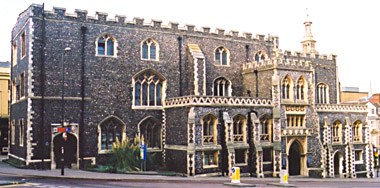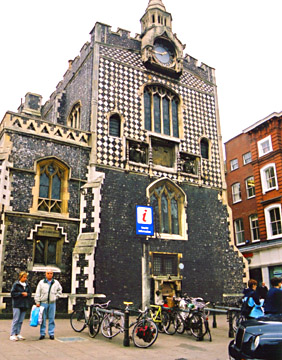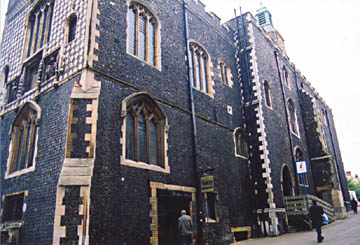
South side of Norwich guildhall.
The doorway at the western end would originally have been an
entrance into the south-west tower.
Photo © S. Alsford
The beginning of building a new guildhall, in 1407, must be understood in the context of the constitutional changes that resulted from the royal charter of 1404, incorporating the borough, granting county status, substituting mayor and sheriffs for the former ballival executive, and endowing the mayor and four colleagues with powers of Justices of the Peace. This followed a period when the ruling class was consolidating its power, with some resistance from elsewhere within the community, and preceded a period of even more intense wrangling over the constitution (see the page "History of medieval Norwich: A division of interests".
At some point in the months following the grant of the charter a resolution established a body of 80 citizens to participate in assemblies, apparently on behalf of and in place of the community at large. Previously an electoral committee had been chosen to act for the community in electing bailiffs; now the 80 were to act for the community but their power was restricted to making nominations – the final decision resting with mayor and council, in the London style. This did not sit well with the community.
In the disputes that followed, there were complaints about a royal charter's (1380) replacement, in its grant of the power to make by-laws, of the community by the town council (representing the community) as the agent for giving approval to any such by-laws. The patriciate counter-attacked by trying to have references to the community, as a constitutional entity, removed from the city charter. The settlement of the dispute introduced a more convoluted procedure for electing the various officials; at the same time members of the upper council were given life-membership status and the dignified title of aldermen, and it was no longer pretended they represented the community, this role falling to the larger body (reduced to 60) now firmly established as a lower council.

East gable of Norwich guildhall.
The clock tower was an embellishment of 1850.
Photo © S. Alsford
The construction of a new home for civic government reflected the ambition of the ruling class to have more a complete and unchallenged control of governance. The introduction of new names – mayor, aldermen, wards, guildhall – suggest an emulation of London. At the same time, the new town hall was a symbol of the enhanced status of the incorporated borough. It has been suggested that the scale of the guildhall, unprecedented outside London, may owe something to the example of "the great city halls which graced the wealthy cloth towns of the Low Countries, with which Norfolk had close trading contacts" [I. Dunn and H. Sutermeister, The Norwich Guildhall, City of Norwich, ca.1978].
The Guildhall replaced an older hall, the Tolbooth, on its sloping site on the north side of the marketplace; a less impressive structure, in terms both of size and construction materials, the Tolbooth had served for judicial and financial administration, but electoral assemblies had to be held in a large chapel at another location. The changes in the early fifteenth century, increasing the judicial powers of city officers and the number of different courts, as well as replacing the popular assembly with a sizable two-tiered council, must have been factors in the decision to spend on a new building. That building would accommodate a larger gaol than its predecessor, as well as city archives and treasury, all functions demanding a sturdy and durable structure. The original function of the Tolbooth, as the point of collection of tolls on goods brought to market and probably of licence fees for stalls, was transferred thereafter – if it had not been earlier – to the Murage Loft, another building in the marketplace, originally for collection of special tolls to go towards wall building.

North side of Norwich guildhall.
The two separate ranges, perhaps imitating nave and chancel of
a church, can be made out.
Photo © S. Alsford
The core building was completed by 1412, thanks to the imposition of special local taxes three times during the construction period, and the impressment of labour (apparently unpaid, except for the carpenters, masons and other skilled craftsmen), with work sometimes going on from dawn to dusk. Donations and bequests by citizens also contributed to what must have been a considerable cost, compared to the annual revenues that were part of the normal city budget. Raising of a roof, tiled with lead, in 1412 enabled the building to begin to be used, first for housing prisoners in the gaol in the vaulted cellars. Benches for the mayor's court were being installed in the same period.
Work continued to outfit, enhance, and construct add-ons to the Guildhall throughout the century. A multi-storey porch was constructed in the 1420s, although this was rebuilt in 1723 and again in the Victorian era; in fact the entire range on the south side (see photo at top) is post-medieval. The building is constructed in the same material as Norwich's medieval churches: flint rubble with a facing of knapped flints and flint fragment infill. The castellations around the roof are shown in the earliest illustration and might be medieval. Most windows were probably glazed, and some contained stained glass images, of which a little survives. The effect of the building must have been, and been intended, to instil some awe and respect in the citizens.
The east gable is decorated in a similar fashion to Lynn's guildhall: a chequer pattern using flint contrasted with freestone; possibly it symbolized the city accounting office (exchequer). Its window is the only one that survived Victorian renovations; the armorials below it are, however, a sixteenth-century addition. Further down, at ground level where a Victorian waterfountain is now placed against the wall, may originally have been an entrance into the crypt; the earliest illustration of the building shows what seems to be a barred entrance or window into the basement. Against this wall scribes set up stalls, where citizens could buy their services, some related to making copies of official records. At the opposite (west) end of the building stood two towers, one housing the treasury, which collapsed in the early Tudor period, and the second surviving until the eighteenth century.
The larger range (west) had on its upper floor an assembly room for the full council, two storeys high, which also served as the sheriffs' court; a private chamber was incorporated at one end. The smaller range, apparently built over the foundations of the Tolbooth, housed on its upper level a smaller chamber where the inner council of aldermen met, doubling as the mayor's court. On the ground floor were prisons for men and women; a small chapel in the porch served prisoners' needs. The dungeons in the crypt were for more dangerous criminals.